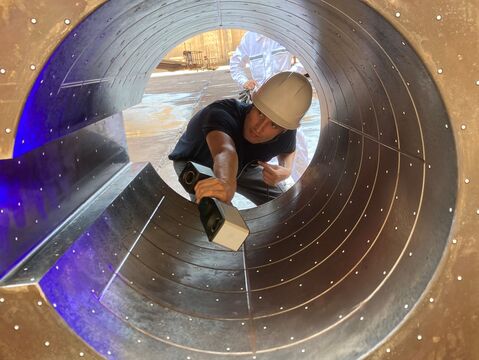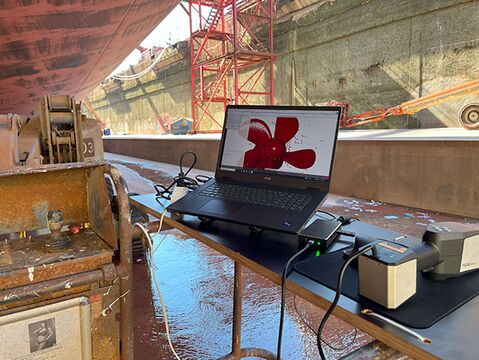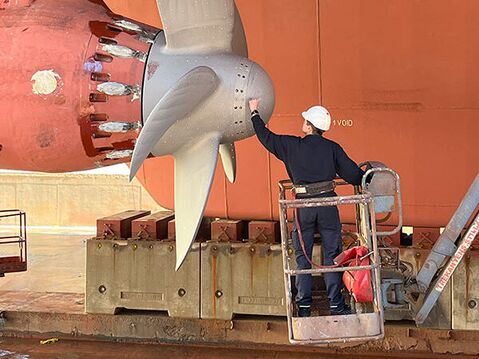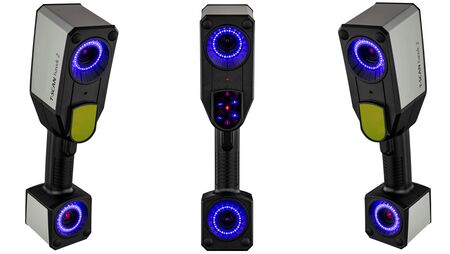From traditional measurements to precise 3D scanning
MarineShaft optimizes repairs of complex components with 3D scanning and photogrammetry
MarineShaft is a leading player in the repair and maintenance of maritime components based in Hirtshals, Denmark. The company serves a global customer base - including shipyards, ship management companies and insurance companies - and works with everything from small propeller shafts and ship screws to propulsion and rudder systems for large ships.
Previously, MarineShaft relied on traditional measurement methods and external subcontractors to achieve the precise measurements required for large and complex components. To optimize this process, the company has now invested in advanced 3D scanning equipment.
Since 2023, MarineShaft has been using the T-SCAN hawk 2 handheld 3D laser scanner combined with the TRITOP system for 3D coordinate measurement. Both solutions from Carl Zeiss GOM Metrology enable faster and more efficient repairs, allowing the company to meet customer demands for high accuracy and fast delivery.
We use 3D scanning to solve specific tasks, but we can also use it as a quality control tool – especially when there are special requirements for the different geometries. – Thomas Bro Wernlund, Mechanical Engineer at MarineShaft
MarineShaft faced several challenges. Traditional measurement methods such as manual measurements with calipers were time-consuming and often not precise enough. This was especially problematic for large and complex components such as rudder blades, propellers and propeller cones.
At the same time, many of the components to be repaired were so large and heavy that transportation to the workshop was difficult and resource- and time-consuming. For example, a rudder blade can easily weigh over 100 tons, which could previously lead to long repair times and higher costs.
Everything we do is almost always urgent repairs, so time is really crucial in all we do. But the equipment we have to repair is big and heavy and not very moveable. - Hanne Magnussen, Marketing Manager at MarineShaft
Previously, MarineShaft also relied on external suppliers for measurements that were beyond the capabilities of their own tools. This could delay repairs and reduce MarineShaft's control over the process.
To streamline their work processes, the company decided to invest in a more flexible and accurate solution.
Photos: MarineShaft
MarineShaft reached out to Zebicon to find the best solution to their challenges. They decided to go with the handheld 3D laser scanner T-SCAN hawk 2 combined with the 3D coordinate measuring system TRITOP from Carl Zeiss GOM Metrology.
With these technologies, MarineShaft can now perform on-site measurements, eliminating the need to rely on external suppliers or transport heavy components to their workshop.
This is because T SCAN hawk 2 provides a complete "point cloud" that gives a detailed picture of the geometry of components. With this data, MarineShaft can perform virtual blue-fit tests to ensure that new or repaired parts fit exactly with other components.
One of the advantages is that once you have the dataset, you have it. So I can always check it again, even when we have sent the repaired parts out of the workshop, and then I can basically just process it in a new way if the need arises. - Thomas Bro Wernlund, Mechanical Engineer at MarineShaft
For example, MarineShaft scanned a large propeller cone directly on a ship in China and sent the data back to the workshop in Hirtshals. This made it possible to manufacture spare parts at home in Denmark with the assurance that they would fit perfectly when delivered to the ship in China.
Zebicon has been responsible for the onboarding of MarineShaft, which has included thorough training in both scanning and the following data analysis.
Of course, it requires some practice and you have to spend time with it to learn the methodology. But it opens up some new measurement methods, and you can suddenly measure something you couldn't before - and then it's easy to take anywhere in the world. - Thomas Bro Wernlund, Mechanical Engineer at MarineShaft
The new measurement methods also allow MarineShaft to present detailed and visually compelling 3D scan reports directly to their customers. This transparent data presentation builds trust as customers can see exactly how individual parts are assessed and customized, leading to a more efficient and secure decision-making process for all parties.
After implementing 3D scanning technology, MarineShaft has achieved
- Expanded service offering and a competitive advantage
- Higher quality assurance
- Efficient on-site surveying
- Reduced repair time
- More precise manufacturing of components
- Greater flexibility and mobility
- Better data sets and measurement reports
- Improved customer communication and increased transparency
MarineShaft's use of 3D scanning is a great example of how a traditional, manual process can be digitized and optimized to create faster, more accurate and more flexible solutions.
MarineShaft is constantly keeping up with the technological development. So when we can see that a tool will really expand our range of services, strengthen us and give us more competencies and repair options - that's where 3D scanning fits in perfectly. - Hanne Magnussen, Marketing Manager, MarineShaft
3D scanning is a technology, which can create a digital 3D model of a physical part. The technology is primarily used for reverse engineering or quality control and part measurement.
Photogrammetry
Photogrammetry is optical 3D coordinate measurement. The technology is used for quality control of large parts, verification of fixtures and hand held tools as well as static deformation analysis.
T-SCAN hawk is a handheld 3D laser scanner. Its intuitive use makes it suitable for reverse engineering and quality control even in harsh and hard-to-reach places.






